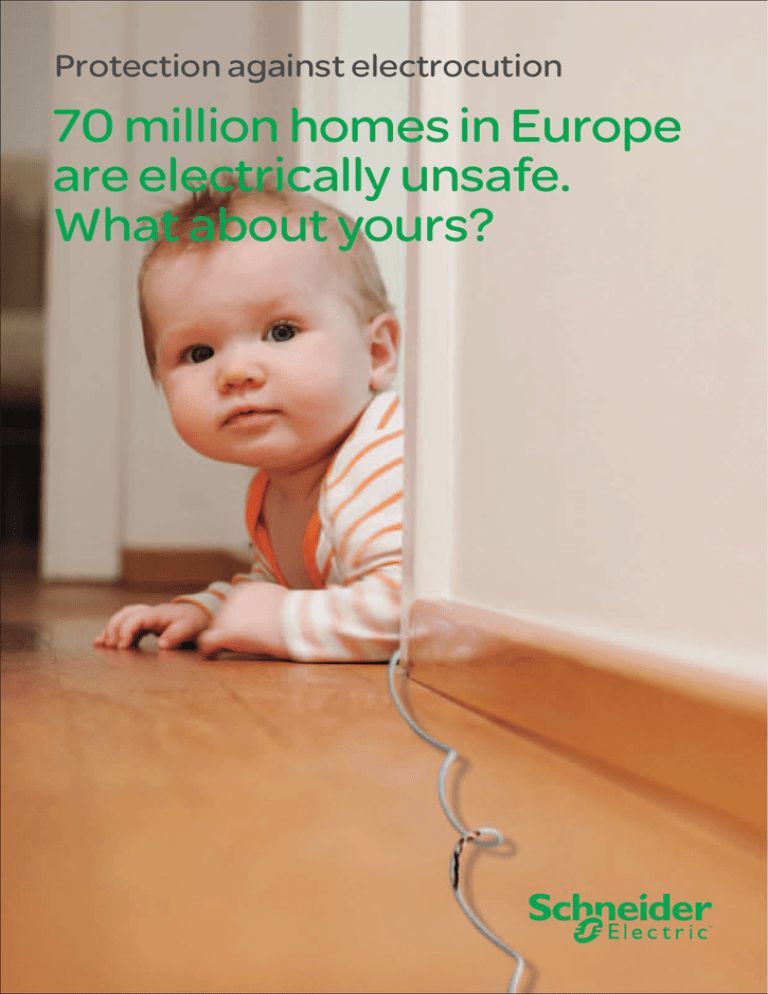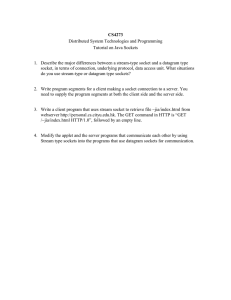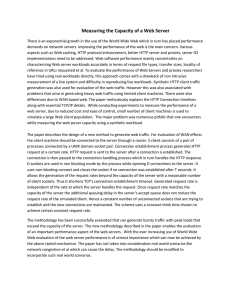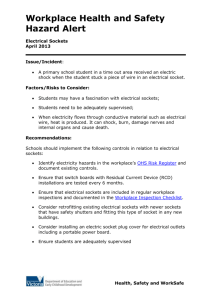
Protection against electrocution
70 million homes in Europe
are electrically unsafe.
What about yours?
Electricity for life
Keep it that way
Where would we be without electricity
The short answer is nowhere. It’s impossible to imagine a world without it.
It’s the great enabler. From the time our electric alarm clocks buzz us awake
in the morning to when we turn off the lights at bedtime, electricity has
powered our whole day.
Don’t take electricity for granted
Yes, electricity is everywhere – like air.
And like air, it’s invisible. Often you can’t actually
see whether you’re protected or not. Danger may
be lurking in old plug, a poorly insulated power tool,
a damaged cordset, or in a kitchen appliance you
handle without drying your hands.
Electricity is everywhere – in the home and the
workplace, inside and outside. So is risk. Electrical
hazards spare nobody. Most at risk, though, are
toddlers. They like to poke their fingers into sockets
and pull on cords. DIY enthusiasts and people who
work with power tools also have high risk exposure.
All it takes is a fraction of a second … and the
consequences can be lethal. Don’t take electricity
for granted.
The older your electrics
are, the greater the risks
Heat, moisture, corrosion, wear and tear all take
their toll. Fixtures age, insulation cracks. In fact your
installation may not meet today’s safety standards.
2
Do you think your consumer unit
protects your family?
In consumer units installed before 20XX, the only safety devices are circuit-breakers
(or fuses if the unit’s even older). They prevent fires caused by short-circuits or cable
overloads. But they don’t protect people from electric shocks.
Short circuits
Overload
They happen when two energised wires come
into contact.
A circuit-breaker trips immediately so preventing
fire from breaking out.
This is when too much current runs through a wire
– because too powerful a device is plugged in, or
too many devices are plugged into a single multiway
adapter block. When a wire overheats it soon
damages everything around it.
One accident is one too many. But there are many more
than one – even today. Figures speak for themselves.
Yet most accidents can be prevented with safety
arrangements that meet standards.
@ In the UK someone dies every week
in an electrical accident at home.
Electrical Safety Council
@ 40% of fatalities in electrical accidents
in the home are children aged under 9.
GRESEL (french voluntary body for research into
electrical safety in the home)
@ In the US, electrocutions are
the fourth most common causes of
industrial fatalities
people get serious electric
shocks and 100 die every
year in France.
Ministry of Ecology, Sustainable Development,
Transport and Housing
Oklahoma State University
3
Play safe – and stay safe
> Power sockets
Sockets account for most electric shocks and electrocutions. That’s why special
safety features are now a legal requirement in all new buildings. Though it’s in old
buildings where they are needed even more.
Damaged plug and socket systems
Damage to flexes
Wall sockets crack, break, and come loose.
When that happens, live parts are exposed. And
they never fail to arouse the curiosity of young
children.
Flexes plugged into wall sockets snake all over the
house. They are prone to all sorts of damage.
Just brushing against a live pin or wire can send
an electric shock coursing through the body. With
sometimes terrible consequences.
@ In the living room and bedrooms, they may be
@ In the kitchen they may be exposed to intense heat,
twisting, nicks, etc.
flattened, knotted, damaged by falling objects, or
gnawed by pets. When a flex is damaged, danger
lurks.
The solution
The solution
Don’t skimp on quality. Buy a brand
with a name. It’s the best guarantee of
safety.
@ Choose shuttered sockets.
@ Ensure sockets are securely screwed
into flush boxes sealed into the wall.
@ Change the socket if it’s old or loose.
@ Get rid of any faulty or damaged
flex immediately.
@ Ensure all your outlets are protected
by RCDs (see page 7 for details)
”A woman mowing her lawn was electrocuted because
the plug and socket system it was connected to had been
incorrectly wired and the house had no RCD.“
Source: http://www.esc.org.uk/public/real-life-stories
4
> Bathrooms
Electricity and water don’t mix. Or rather, they do. There lies the danger. Water carries
electricity efficiently. Wet skin reduces the body’s resistance and it sustains serious
injury in the event of a shock.
Light fittings should be encased and no electrical equipment or outlets should be
within reach of the shower or bath tub.
Never use a hair dryer or electric razor when in the
bath or standing in the shower.
If a device falls into water, never try to pick it up.
Unplug it first.
The solution
Your electrical
equipment must
comply with
IEC 60 364.
All metal
parts must be
connected to the
green-yellow part
of the electrical
network.
Complying with
distances makes
it impossible
to come into
contact with any
electrical parts
when in the bath
or shower.
Volume 0:
> No electrical part
at all.
Volume 1:
at reach from the bath
or shower with arms up
> Only 12V isolated
fittings (SELV*
supply)
Volume 2:
maximum reach from
the bath or shower
> Transformer isolated
sockets (“razor”
type)
> Class II insulated
lighting and heaters.
Volume 3:
All devices, ether
protected by 30 mA
rated RCD.
> Or SELV* supply
(maximum
50 volts).
* SELV : safety extra low
voltage
5
> Lighting: minor repairs, major risk
Changing bulbs, fixing loose wires, and making
other minor repairs to lamps actually account for
a high share of electrical accidents in the home.
The solution
Always turn off the lighting circuit in the consumer unit
before any repair. Turning off at the wall switch isn’t enough.
What if someone comes in and switches it back on?
If wall or ceiling-mounted lights have metal parts,
make sure their earth pin is connected to the
green-yellow wire.
RCD-protected lighting circuits will, however,
be your surest safety guarantee.
> Machines and domestic appliances
Refrigerators, washing
machines, air conditioning
units, and even lighting
can be hazardous. If an
internal wire works loose
or loses just a scrap of
its insulating sheath,
it energies the metal
housing. The slightest
touch can result in a nasty
shock or worse.
The solution
Any appliance with metal housing must be grounded by:
@ green-yellow wires all connected together
@ ground pins in plugs and sockets.
Grounding ensures that a protective device trips as soon
as a live electrical part touches a metal housing.
Make sure:
@ all your socket outlet are equipped
with an earth pin
@ all directly connected stationary
equipment (kitchen appliances, water
boiler, AC units…) are firmly connected
to the green-yellow wire of your
electrical network.
6
Word of warning: A socket isn’t safe just
because it has a ground pin. Ask your
electrician to check all your sockets and
all the metal parts in your bathroom are
properly grounded.
RCDs for failsafe protection
against electrocution
Because you can’t always see damaged insulation or loose wires,
new regulations require homes to be fitted with RCDs.
Residual current devices (RCDs) are highly sensitive devices that
trip immediately when an electric shock situation is detected.
If anybody gets an electric shock it stops the electricity flow.
It would be particularly effective in old buildings with ageing
installations, where modern regulations don’t apply.
Does your electrical installation
have a residual current device?
Compulsory
standard
Wiring regulation
(IEC.60 364) makes it
compulsory to install
30 mA rated RCDs on circuits
supplying:
@ all power sockets
@ all devices in bathrooms
and other wet locations.
Does your consumer unit have
devices with a white pushbutton.
@ No?
@ Yes?
You’re not protected
against electrocution.
Contact an electrician
for an upgrade.
Press the white button.
The RCD will trip
immediately.
When the RCD has tripped, check the protected
parts of your home:
@ T ake a light and plug
it into each power
socket of your home.
If none works, you’re
RCD-protected.
If any socket still
works, you’re still not
fully protected from
electric shocks.
Be careful to check
all the sockets, lights
and appliances in your
bathroom. Nothing should
work.
@ If any tested circuit
still works, you’re
not fully protected
from electric shocks.
Ask your electrician
to upgrade your
installation in line
with current safety
regulations.
Flick up the orange switch on the RCDs to turn
the power back on.
7
Trust your electrician
to make your home safe
Safety is serious business – and it can be very technical, too. Only qualified
electricians can make your home safe and protect your family from the risk of
electrocution. So, whether your home is a modern building or – in fact, especially –
if it’s an old one, call an approved electrical contractor.
Schneider Electric:
the guarantee of a world
leader’s expertise
Electricians:
their expertise means
your safety
How can you be sure the safety devices in your
consumer unit will do their job at critical time?
Schneider Electric, world leader in electricity
management, brings you:
@ nearly a century of experience in electrical protection,
@ g lobal, unanimously acknowledged quality in all types
of buildings.
Because electricians are electricity professionals they
are also safety professionals. They know rules and
practices inside out.
Need to check your electrical installation? Rewire or
replace faulty and ageing parts? Upgrade your safety
system so that it complies with current standards?
Trust your qualified electrical contractor.
Schneider Electric works constantly and closely with
electricians. We train electricity professionals and keep
them up-to-date with new products and regulations.
That’s because Schneider Electric’s business is to make
your home safe, comfortable, and energy efficient.
Make the most of your energy
SM
Schneider Electric Industries SAS
Head Office
35 rue Joseph Monier
92506 Rueil-Malmaison Cedex- France
Tel.: +33 (0)1 41 20 70 00
www.schneider-electric.com
©2012 Schneider Electric. All Rights Reserved. Schneider Electric and Make the most of your energy are trademarks owned by Schneider Electric Industries SAS or
its affiliated companies. All other trademarks are property of their respective owners. Design: Power Business Communication. M9DP94EN



